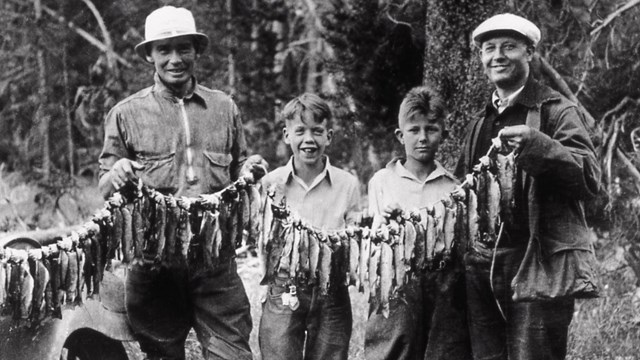|
Visit our keyboard shortcuts docs for details
Journey through Yellowstone's aquatic ecosystems. Native Fish SpeciesYellowstone has 12 fish species native to its lakes and streams. Native sport fish include two species of cutthroat trout, Arctic grayling, and mountain whitefish. Yellowstone’s native fish underpin natural food webs, have great local economic significance, and provide world-class visitor experiences.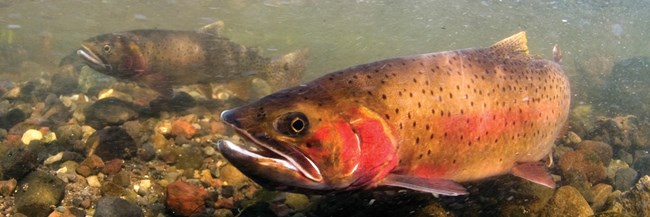
Yellowstone Cutthroat TroutYellowstone cutthroat trout (Oncorhynchus virginialis bouvieri, YCT) are the most widespread native trout in the park and the dominant fish species. They provide an important source of food for an estimated 16 species of birds and mammals including bald eagles, grizzly bears, and river otters. 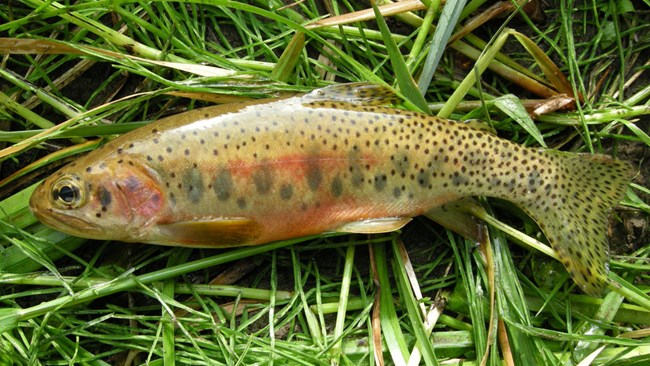
Westslope Cutthroat TroutWestslope cutthroat trout (Onchorhynchus lewisi, WCT) are the most widely distributed species of cutthroat trout in the U.S. but have undergone range-wide declines. Genetically pure WCT were thought to have been extirpated from their native range in Yellowstone National Park in the Gallatin and Madison river drainages due to hybridization with nonnative rainbow trout and YCT stocked outside of its historic range, and competition with nonnative brook trout and brown trout. However, two populations of genetically pure WCT were discovered in the early 2000s in Last Chance Creek, an indigenous WCT population, and in Oxbow/Geode Creek complex, containing WCT descendants from “cutthroat trout” stocking events in the Yellowstone River drainage before different cutthroat trout species were widely recognized. Conservation actions by the National Park Service and its partners have restored and expanded WCT to nearly 70 stream miles and 280 lake acres, including, Goose, High, Grebe, and Wolf lakes.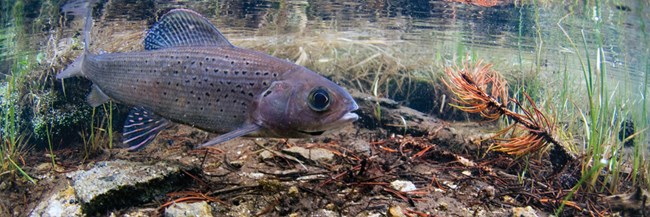
Arctic GraylingArctic grayling (Thymallus arcticus, grayling) historically existed in the contiguous U.S. in two disjunct groups in Michigan and Montana/Wyoming. The Michigan group was extirpated in the 1930s and the Montana/Wyoming group has undergone drastic declines. In Yellowstone National Park, grayling historically occupied fluvial habitat in the Gallatin and Madison river drainages, including the lower Gibbon and Firehole rivers, and Grayling Creek. However, fluvial grayling were extirpated from streams and rivers in the park by the mid-1900s, presumably resulting from nonnative fish introductions and habitat degradation with the construction of Hebgen Reservoir in 1915.The only known grayling populations left in the park were descendants of grayling with the lacustrine life history that is nonindigenous to Yellowstone National Park that were stocked in Cascade and Grebe lakes and did not establish in riverine habitats. From 2017–2021, the National Park Service implemented a grayling and WCT conservation project in the upper Gibbon River drainage. Biologists removed nonnative rainbow trout and the lacustrine-sourced grayling, and stocked more than 100,000 WCT embryos and fish, and 170,000 fluvial-sourced grayling fry. An additional 7,000 grayling fry were stocked in Grebe Lake in 2023. From 2015–2017, the National Park Service also reintroduced nearly 60,000 WCT embryos and fish, and 110,000 fluvial-sourced grayling embryos and fry to upper Grayling Creek in the Madison River drainage. 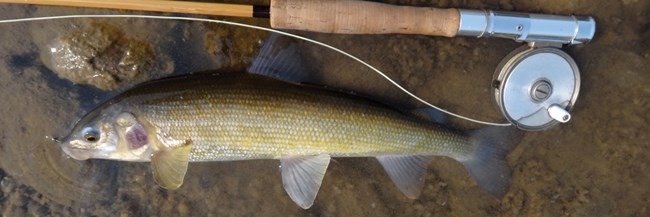
Mountain WhitefishThe mountain whitefish (Prosopium williamsoni) is a slender silver fish, sometimes confused with Arctic grayling. It lives in Yellowstone’s rivers and streams and requires deep pools and clear, clean water. This species is very sensitive to pollution. The mountain whitefish has persisted in its native waters, unlike the Arctic grayling. Mountain whitefish are commonly caught by anglers in most of the park’s large rivers. They are less common in smaller streams.Rocky Mountain Sculpin(formerly Mottled Sculpin, pending confirmation) The Rocky Mountain sculpin (Cottus bondi) lives primarily in shallow, cold water throughout Yellowstone, including the Yellowstone River downstream of the Lower Falls. It has modified pectoral and pelvic fins to help it move and grip the bottom of the stream. It lacks scales and a swim bladder. It eats small insects, fish, and fish eggs, and is consumed by trout.The Rocky Mountain sculpin (Cottus bondi) lives primarily in shallow, cold water throughout Yellowstone, including the Yellowstone River downstream of the Lower Falls. It has modified pectoral and pelvic fins to help it move and grip the bottom of the stream. It lacks scales and a swim bladder. It eats small insects, fish, and fish eggs, and is consumed by trout. Utah ChubThe Utah chub (Gila atraria) is the largest of the minnows (12 inches) and has a robust round body. It is native to the Snake River drainage and abundant in Heart Lake and the Heart River. They have a high reproductivity capacity with a 12-inch female carrying up to 90,000 eggs. Utah chub prefer slow, warm waters with abundant aquatic vegetation.Redside ShinerThe Redside shiner (Richardsonius balteatus) is a species of minnow most often found in lakes along the shallow margins. It is native to the Snake River drainage but has been introduced to Yellowstone Lake where it is now common.Longnose DaceThe longnose dace (Rhinichthys cataractae) has an elongated, rounded body that tapers towards the head and tail. It grows to about 6 inches and is often found behind rocks and in eddies of cold, clear waters of the Yellowstone, Snake, and Madison river drainages. It can also be found in Yellowstone Lake. Longnose dace will feed on aquatic insects, aquatic vegetation, or algae.Speckled DaceThe speckled dace (Rhinichthys osculus) is found in the Snake River drainage. It is similar in body form and size to the Longnose dace but has a much smaller distribution. Interestingly, the Speckled dace and Redside shiner have naturally hybridized in several locations in southern Yellowstone.Mountain SuckerThe Mountain sucker (Catostomus platyrhynchus) is found in cold, fast, rocky streams and some lakes. It is widely distributed throughout YNP. It can be misidentified with the Longnose dace as they can have similar body forms and size. The back and head are typically dark brown or greenish brown, underside is white, and both males and females have a red/orange strip along the side. Typically grow to a maximum of 6 inches.Longnose SuckerThe Longnose sucker (Catostomus catostomus) is native to the Yellowstone River drainage below the Grand Canyon and was introduced to Yellowstone Lake and its surrounding waters. It is equally at home in warm and cold waters, streams and lakes, and clear and turbid waters. These large, round fish can grow to 22 inches or more and weigh in at over five pounds. They are typically silvery to blueish/gray and develop a reddish band along their side during the spawning season.Concurrent with the decline in cutthroat trout is a steady, long-term decline in the introduced Longnose sucker population within Yellowstone Lake. The mechanism causing this decline is unclear. Longnose suckers are found primarily in shallow water and spawn in tributaries during the spring. Predation by Lake trout during the summer is not significant but it is possible that consumption of suckers by lake trout is higher during winter when water temperatures are extremely cold, allowing lake trout to exploit shallow water habitats where the suckers reside.Utah SuckerThe Utah sucker (Catostomus ardens) is native to the Snake River drainage and can grow to similar size as the Longnose sucker. This species is abundant in Heart River and Heart Lake. Utah suckers have been aged at over 20 years.Nonnative Fish SpeciesNonnative fish species that were introduced to the park in the late 1800s and early 1900s include Rainbow trout, Brown trout, Brook trout, Lake trout, and Lake chub. Fish species native to Yellowstone have also been transported outside of their native waters. Although nonnative trout are also important to the angler experience in Yellowstone, they have contributed to a decline in the park’s native fish species.Nonnative fish distributions and their influence on native fish are not static. While Rainbow trout have not been intentionally stocked since the 1930s, the hybridization of cutthroat trout resulting from Rainbow trout range expansion continues to be the greatest threat to the park’s remaining stream dwelling cutthroat trout populations. Additionally, Lake trout were introduced to Yellowstone Lake by unknown means in the mid-1980s and first appeared in angler catches in 1994. The Lake trout population expanded and, over the following decade, caused a rapid decline in the YCT population in Yellowstone Lake. Through the most intense fish control program in the NPS, the YCT numbers are steadily improving in Yellowstone Lake.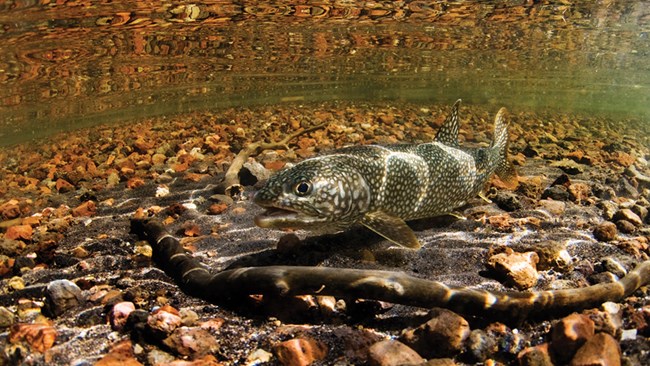
Lake TroutLake trout (Salvelinus namaycush) are native to Canada, Alaska, the Great Lakes, New England, and parts of Montana. Lake trout were intentionally stocked in Lewis and Shoshone lakes in 1890 by the U.S. Fish Commission (a predecessor of today’s US Fish & Wildlife Service). Although Lake trout need energy-rich prey to continue to grow, they can persist for years with minimal food resources.The species was first documented in Yellowstone Lake in 1994. Evidence from chemical patterns in Lake trout ear bones (otolith) sampled in the late 1990s indicate that the initial stock originated from nearby Lewis Lake sometime in the 1980s. Despite major efforts to remove them by gillnetting, Lake trout have had a significant ecological impact on native YCT, which are an important food source for other native animals.Lake trout differ from cutthroat trout as potential prey because they can grow larger, occupy deeper areas of the lake, and spawn in the lake instead of in shallow tributaries. Lake trout also consume foods that have historically fed cutthroat trout in Yellowstone Lake, thereby making cutthroat trout recovery impossible until the Lake trout population is suppressed. 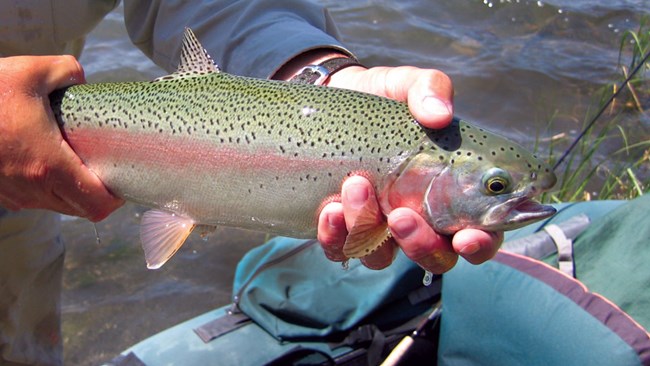
Rainbow TroutRainbow trout (Oncorhynchus mykiss) are native to North America in waters that drain to the Pacific Ocean from northern Mexico to Alaska. Of the nonnative fish in Yellowstone, Rainbow trout have the closest geographic origin. As the most adaptable member of the salmonid family, they have been successfully introduced throughout the world. Unfortunately, they readily hybridize with cutthroat trout and produce fertile offspring.Cutthroat x Rainbow Trout HybridsIn waters where rainbow trout have been introduced, there has been a serious degradation of the cutthroat trout population through interbreeding.Presently, hybridized cutthroat trout exist throughout the Bechler, Falls, Gallatin, Gardner, Lamar, and Madison river drainages, and the Yellowstone River below the Upper Falls. Hybrids will have characteristics consistent with both species.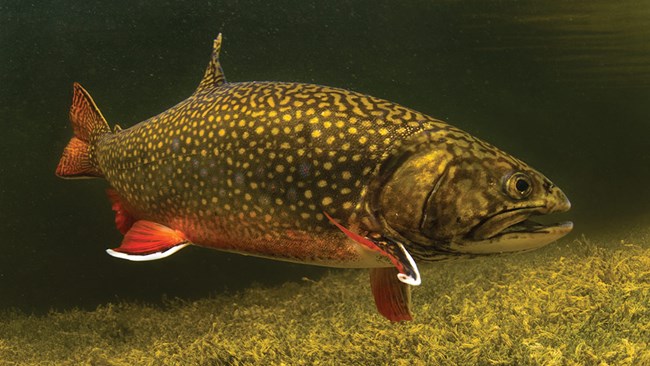
Eastern Brook TroutEastern brook trout (Salvelinus fontinalis) was the first nonnative species introduced in Yellowstone. They were stocked in the (then fishless) Firehole River in 1889. Brook trout are native to the eastern and northeastern United States from Hudson Bay down to the Carolinas and through the Great Lakes. Males can be mature at two years old and females at three. Their short generation times have made brook trout successful invaders that have quickly displaced cutthroat trout in areas where they have been introduced.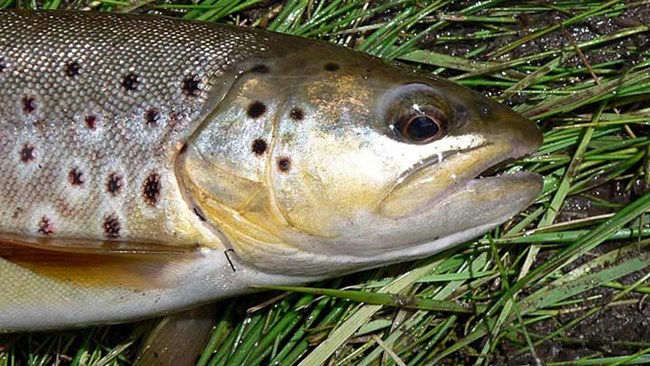
Brown TroutThe Brown trout (Salmo trutta) is the only nonnative fish species in Yellowstone that is not native to North America. This European species was introduced to Yellowstone in the later part of the 19th century and was recorded as two different species—the Von Behr and the Loch Leven brown trout. These are now thought to be varieties of the same species, and most of the populations in Yellowstone are indistinguishable. They can be aggressive predators and can grow to large sizes. Brown trout have a higher thermal tolerance then Yellowstone’s native salmonids and thrive in the Firehole River. Anglers report that they are notoriously finicky when it comes to striking a fly or lure.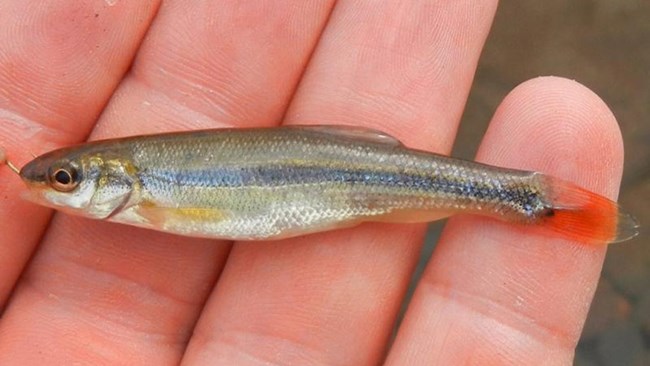
Lake ChubThe Lake chub (Couesius plumbeus) is native to the Missouri and Yellowstone River drainages in Montana and Wyoming, but not to Yellowstone National Park waters. It was most likely introduced by bait fishermen into Yellowstone Lake, McBride Lake, and Abundance Lake in the Slough Creek drainage.More Information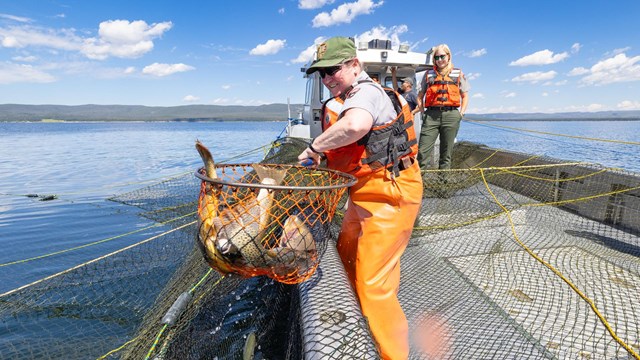
Fisheries Management
Learn how the Native Fish Conservation Program works to preserve Yellowstone Lake cutthroat trout and to restore fluvial trout populations. 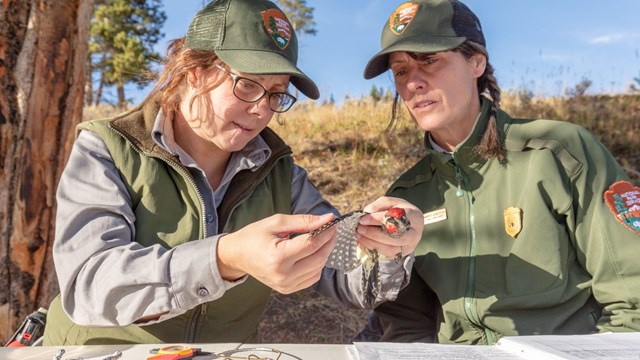
Science Publications & Reports
View science publications and reports created by Yellowstone's Center for Resources on a variety of park topics. 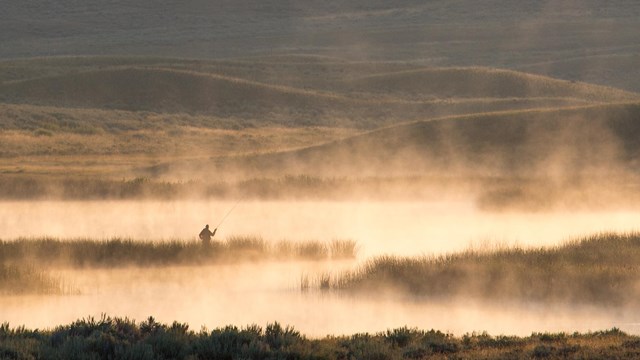
Catch a Fish
Be a responsible angler and understand the regulations before you come. |
Last updated: January 21, 2025

